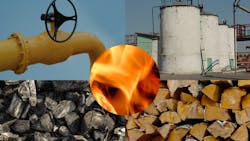Sustainable Chemical Feedstocks: 5 Questions for McKinsey & Co.
In March, U.S. President Joe Biden set a goal for the chemical industry to satisfy at least 30% of its demand using “sustainable and cost-effective biomanufacturing pathways.” The target was part of a report the administration released on March 22 outlining priorities to advance safe, sustainable biotechnology and biomanufacturing in the United States.
McKinsey & Co. highlighted the target a few weeks later during a webinar on sustainable feedstocks in the chemical industry, stating that “biobased chemicals and materials play a central role in [the administration’s] overall aspirations.” Chemical Processing recently discussed some of the key points from that webinar, “Re-Carbonizing chemicals with sustainable feedstocks,” with one of the webinar presenters, Axel Spamann, partner, McKinsey & Co. Here’s an edited version of that discussion.CP: In your presentation, you refer to “zero CO2 end products.” How do you define a zero CO2 end product?
A zero CO2 end product is one where end-to-end CO2 emissions are net avoided, meaning that from raw-material production upstream to the retail of the end-product downstream, no additional CO2 is released into the atmosphere. That may mean raw materials production, such as chemicals, would need to decarbonize by using renewable energy sources and/or sustainable feedstocks. Logistics would need to decarbonize, for example, by avoiding emissions from fossil fuels. In case of hard-to-abate supply chain steps, full compensation of emissions or capturing and sequestering CO2 emissions via CCS (carbon capture and storage) could also be interim solutions to decarbonize. Zero CO2 end products would also require thinking about potential end-of-life emissions, such as emissions from recycling or incineration.
CP: You discuss different sustainable feedstocks. What are some of the advantages and disadvantages of each?
We consider three types of sustainable feedstocks: recycled materials (i.e., wastes), different sorts of biomass (e.g., sugar, wood, oil), and CO2 extracted from the air or captured at an emission source. The best sustainable feedstocks alternative may depend on a player’s specific target molecules, access to inputs and region of production. Our analyses of costs, availability and technological readiness suggest that most companies could benefit from pursuing sugar biomass over the short term before moving to CO₂-to-x over the medium to long term. However, the specific use of biomass would need to be carefully assessed along with food availability and competition.
CP: Why is sugar potentially more beneficial over other feedstock options?
Oil biomass is great for its versatility and the ability to use existing chemical manufacturing facilities. However, where sugar can be used, costs tend to be somewhat lower. Also, efficient oil plants tend to be perceived as problematic regarding sustainability due to potential land-use change and biodiversity issues. While by no means simple to execute, there is lots of potential for truly sustainable sugar sources.
CP: What are some of the challenges chemical producers face when considering more sustainable materials?
Customers of chemical manufacturers, such as automotive and consumer goods companies, have committed to aggressive decarbonization targets. This puts pressure on the chemical industry. The manufacture of chemicals is both energy and carbon intensive, with some processes producing large amounts of CO2 as a byproduct. This means it’s a particularly difficult-to-abate industry.
One possible solution is the use of sustainable feedstocks. The challenge in the years to come may be determining which feedstocks and conversion technologies are most effective for which products and in what regions of the world. Companies would essentially need to develop evaluation criteria around feedstock availability, technology maturity and economics. The answers to these questions would require a company-specific assessment as they vary depending on each organization’s specific target molecules, their position within the chemical value chain, and region of production.
Once they have selected their preferred path, companies are likely to face two main challenges: 1) sourcing of high-quality sustainable feedstocks, and 2) securing volume sales to de-risk investments. Our findings indicate that players could mitigate uncertainty by entering long-term supply and offtake agreements and helping to ensure their suppliers use regenerative farming practices.
CP: How would a shift toward more sustainable feedstocks impact chemical producers at the operations/engineering level?
That really depends on the feedstock routes that a chemical producer may be using. As such, using bio-naphtha from oil biomass would mean only few changes in terms of procurement and potentially mass-balancing reduced CO2 emissions to intermediates produced via steam crackers. Other conversion routes that go from sugar biomass via cell-free conversion or fermentation to intended target chemicals may mean having to build new plants with dedicated technology. While each sustainable feedstock and related conversion technology could have its advantages and disadvantages, the applicability for any chemical player willing to decarbonize may also depend on their legacy production setup and position in the chemical value chain.
About the Author
Jonathan Katz
Executive Editor
Jonathan Katz, executive editor, brings nearly two decades of experience as a B2B journalist to Chemical Processing magazine. He has expertise on a wide range of industrial topics. Jon previously served as the managing editor for IndustryWeek magazine and, most recently, as a freelance writer specializing in content marketing for the manufacturing sector.
His knowledge areas include industrial safety, environmental compliance/sustainability, lean manufacturing/continuous improvement, Industry 4.0/automation and many other topics of interest to the Chemical Processing audience.
When he’s not working, Jon enjoys fishing, hiking and music, including a small but growing vinyl collection.
Jon resides in the Cleveland, Ohio, area.


